There are many myths surrounding programmatic advertising which can leave marketers confused about where to start and whether it’s suitable for their business.
In reality, programmatic can be a valuable channel to include in your marketing arsenal in order to find and target new audiences. In this blog, we will guide you through the world of programmatic advertising, covering what it is; different programmatic advertising platforms; the targeting and ad formats available, and the benefits and limitations of the channel.
- What is programmatic advertising? Key definitions
- Programmatic myths
- “Programmatic is for brand-building only”
- “Programmatic can only be accessed with large marketing budgets”
- “Programmatic activity is hard to measure”
- How does programmatic advertising work?
- Real-time bidding work: how it works
- Programmatic advertising platforms and ad format types
- Display & Video
- YouTube Video
- Custom publisher formats
- Audio
- Connected TV
- Programmatic digital out-of-home
- Programmatic targeting: contextual and audience data
- How important is creative in Programmatic Advertising?
- Top tips for effective creatives
- Personalise your creative
- Adapt your ads to their environment
- Interactivity
- Be brand-led
- What are the benefits of Programmatic Advertising?
- Scale
- Efficiency
- Targeting
- Formats
- What are the challenges of Programmatic Advertising?
- Brand safety
- Upper funnel
- Ad fraud
- What’s next for Programmatic Advertising?
- Trends and predictions for 2023
- 5G boosts mobile
- Cookieless solutions
- Digital out-of-home expansion
- Best practices for Programmatic campaigns in 2023
- Next steps
- Programmatic advertising FAQs
What is programmatic advertising? Key definitions
To give you a rounded view, we’ve hand-picked a few definitions that we think sum up programmatic advertising well:
“Programmatic ad buying is the use of software to buy digital advertising. While the traditional method includes requests for proposals, tenders, quotes, and negotiation, programmatic buying uses algorithmic software to buy and sell online display space.”
Digital Marketing Institute, 2021
“Programmatic advertising differs from more traditional media buying methods in its use of automation. It analyses many user signals to ensure that ads serve the right person, in the right place, at the right time.”
“The use of automation in buying and selling of media.”
As of 2021, the programmatic display advertising market was valued at $451.3 billion and is expected to reach $9473.3 billion by 2031. Recent Brand Equity statistics show that 72% of all digital displays are now programmatic, and that 58% of marketers are looking to increase their spending on display. Areas for growth in 2023 include Connected TV (expected to grow by 14.4%) and mobile (expected to grow by 52%).

Programmatic myths
Whether you’re familiar with programmatic advertising or not, you might have heard a few misconceptions surrounding the channel. Let’s dispel some of these common myths:
“Programmatic is for brand-building only”
Whilst programmatic has a strong capability to help you reach a prospective audience, remarketing tactics can re-engage users and bring them back to your website, engaging those further down the funnel.
“Programmatic can only be accessed with large marketing budgets”
For mid-sized and smaller businesses, a common misconception is that programmatic is for big advertisers with big budgets and therefore not a viable channel for them to invest in.
In reality, programmatic advertising can be explored by businesses with a wide range of different marketing budgets. Bid strategies, audience data and real-time optimisation mean programmatic is efficient and low in wastage.
“Programmatic activity is hard to measure”
To help you understand the impact of programmatic, you can quantify your branding impact with Brand Lift studies. At the same time, Google Analytics allows you to measure traffic quality and conversion performance to help you identify where programmatic sits within your marketing mix.

How does programmatic advertising work?
Programmatic advertising works by automating the ad buying process. Ad inventory is bought and sold in real time via real-time bidding (RTB), which uses action-based software instead of manual negotiations. Advertisers pay for impressions based on the users who view their ads rather than a flat site-wide CPM.
To help you better understand how it works, we’ll compare programmatic media buying to more traditional methods: If you wanted to set up a digital campaign on the home page of The Guardian, you would need to set up an end-to-end deal with that publisher, where you would have a set budget, carry out negotiations, and set up manual reporting for the duration that your ad is placed. This would mean that anyone could see your ad regardless of your target audience, which is fine if you only wanted to appear on that one page and achieve broad reach.
The problem with this approach is scalability. If you want to be on 10, 100 or 1000 different sites, this more manual process is going to become unmanageable. You would have to set up that end-to-end deal with every single publisher, which is a lot of work! In addition, you would have no control over who sees your ad – resulting in budget and time wastage.
This is where real-time bidding steps in to make this process a lot simpler, allowing you to get the most out of your time and budget. Real-time bidding creates an auction environment across millions of sites where advertisers can bid to show ads to specific users based on data about that user. With the auction system, you no longer have to arrange end-to-end deals, and you can target audiences more effectively by using user data. All of this means you can serve the right ad to the right user at the right time.
Read on to learn more about how real-time bidding works in technical terms.
Real-time bidding work: how it works
Imagine a consumer visiting a web page that serves ads. As they land on the page, the ad impression is listed for auction on the ad exchange by the website owner’s supply-side platform (SSP). The advertiser’s demand-side platform (DSP) offers bids for the impression if it matches their criteria (user targeting). The highest bidder wins the impression and the winning ad is served on the website and shown to the person. This process takes place in less than 100 milliseconds.
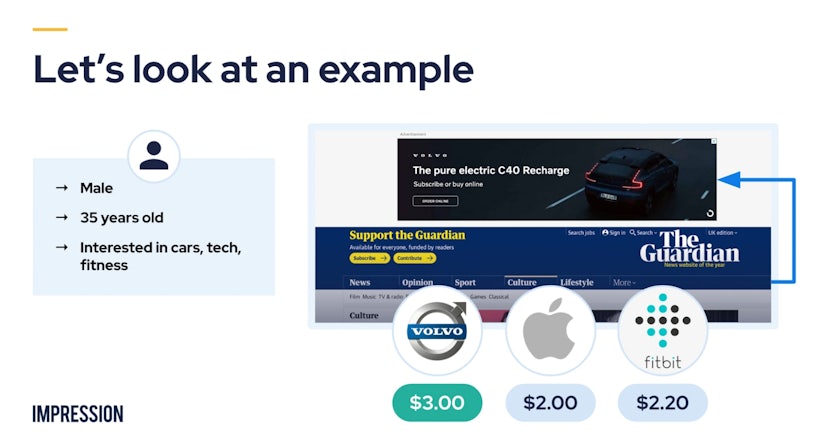
Programmatic advertising platforms and ad format types
Programmatic is much more than just display ads. In fact, programmatic advertising is all around us, whether you’re checking the news or scrolling on your phone, you probably see several programmatic ads each and every day. Here are some of the most common programmatic ad formats available.
Display & Video
You can see these billboard-type ads on the top of homepages on desktop but also on mobile as you scroll through articles and webpages. Display and video ads are the bread and butter of programmatic advertising because this channel is scalable and offers relatively low CPMs when compared to others.
As a result, programmatic display is easily accessible for advertisers of all sizes with different budgets. Another key advantage is that depending on your targeting criteria, it’s a flexible format that can be utilised throughout a full-funnel campaign – from contextual or audience targeting to build brand awareness all the way down to remarketing with CRM data for conversion and lead generation.
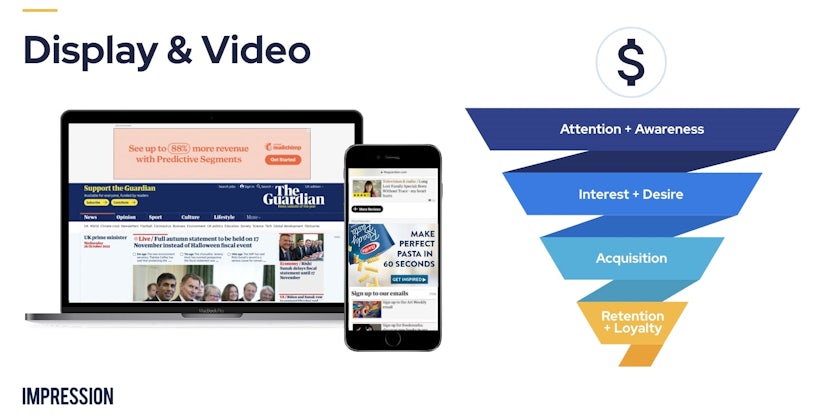
YouTube Video
YouTube advertising offers a wide range of formats that advertisers can take advantage of such as skippable and unskippable ads that are featured as in-stream, bumpers or video action ads. These are only some of the most popular YouTube Video programmatic ads that can be utilised throughout the marketing funnel, either to raise awareness, engage or drive action.

Due to the video format, we would suggest that these types of ads work best from the middle to upper funnel. But, depending on the strength of your remarketing audience or your CRM data, you can see success at the bottom of the funnel too.
YouTube videos are an affordable option for medium to large businesses; similar to Display & Video and depending on your targeting criteria, you can reach a wide range of audiences.
Custom publisher formats
These types of ad formats consist of examples such as custom webpage background skins, like from IMDb or through in-game advertising from publishers such as Bidstack (see below).
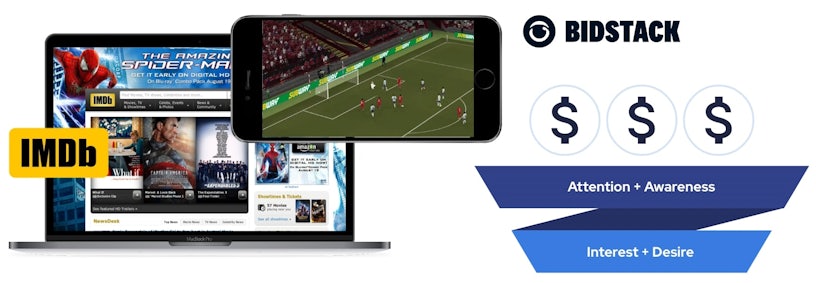
Custom publisher formats sit mostly towards the upper funnel of your campaigns, but could also contribute to your middle-of-the-funnel activity depending on the context of the ad and where it is published. For example, someone who visits an IMDb page would be interested in movies, so they’re likely to be interested in seeing ads for other movies (as with the Spider-Man programmatic ad shown above). On the other hand, the Bidstack in-game ad sits more within the awareness stage of the funnel, generating unexpected visibility to drive low-level brand awareness.
Audio
Audio is one of the only examples where someone doesn’t necessarily have to be looking at a screen, meaning you can reach someone within a completely new moment – such as engaging in another activity (i.e. a commute, on a run, cooking). It also means they don’t need to have a digital device in their hand or sat in front of them too.
One of the biggest publishers of audio-based programmatic ads is Spotify, with audio ads featured in-app or as a pop-up on their website. As these ads are not always delivered when you are engaging with a screen, they work well for raising brand awareness.
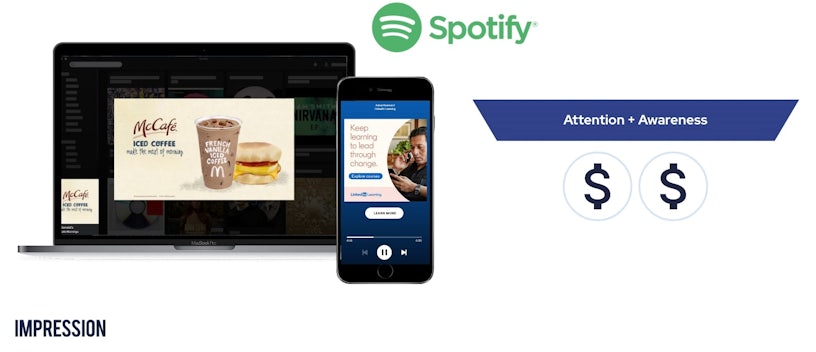
Connected TV
A good opportunity for branding, Connected TV opens up the biggest screen in your house to your adverts. Connected TV provides you with the opportunity to show some high-quality creatives to potentially more than one person at any given time. There’s a lot of movement in this format to diversify the different types of ads you can show on Connected TV. Historically, it has been similar to your standard TV adverts, however, several steps have been taken to possibly introduce shoppable and interactable ads, allowing them to buy products through Connected TV.
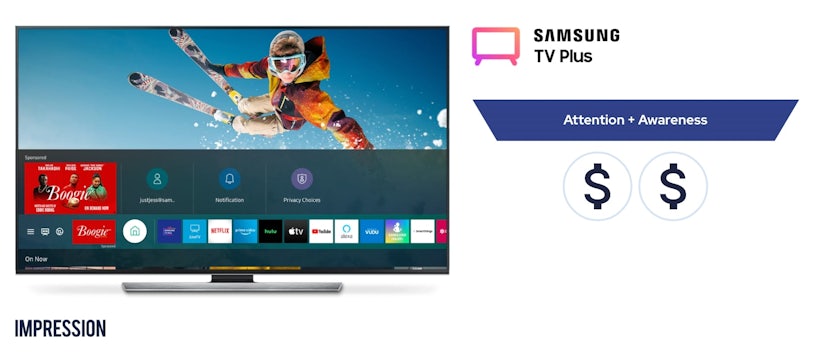
Programmatic digital out-of-home
Digital out-of-home (DOOH) is set to be one of the most trending forms of programmatic advertising. Despite being stalled by the pandemic back in 2020, as we are out and about more, we are seeing its use gain more traction. Although it may be more difficult to control, DOOH can be engaging and better supports raising the awareness of your brand as it has a limitless opportunity to reach people with geo-targeted messaging.
There has also been a movement to link DOOH with APIs in order to pull information such as flight data to advertise an airline. For example, the British Airways DOOH ad shown below references a flight that is currently flying overhead using real-time flight and destination data. Previously, typical billboard ads were not as measurable, so we’re excited to see these be incorporated into a wider marketing mix.
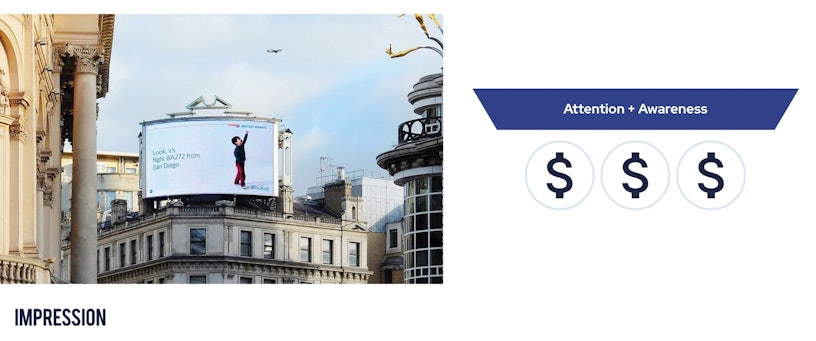
Programmatic targeting: contextual and audience data
Broadly, the data you can target is split into two types of data: contextual and audience data.
Contextual data is the content on the page that your ad is going to appear on, such as specific websites, pages or apps, as well as categories based on the content of that site, i.e fashion webpages. This can be narrowed down to specific keywords that appear on the page too.
Audience data is collected from users via their digital footprint across the web. This includes first-party data from your CRM and site visitors – which is becoming more crucial as third-party cookies begin to phase out. Second- and third-party data can come from publishers or from cookie data based on interest or browser history. Finally, we have geo data which allows you to be granular by specifically targeting criteria such as postcodes and device IDs.
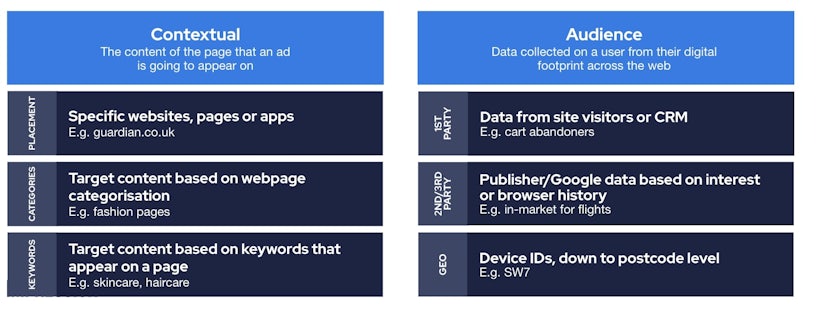
Other targeting options are available, however, contextual and audience data are some of the most important to consider for your targeting criteria across a full-funnel strategy.
How important is creative in Programmatic Advertising?
Ad creatives should be a major consideration for your programmatic advertising strategy. According to an IPSOS study, up to 75% of an ad’s impact is determined by the creative quality. This means that you could have a watertight, granular audience strategy that is based on market research and audience insights, but still fall short if your creative isn’t resonating with that audience.
Top tips for effective creatives
Personalise your creative
Creatives that are personalised to your audience generate up to 40% more revenue. If you’re able to serve a message that aligns with their interests as part of your programmatic advertising strategy, they’re a lot more likely to be engaged (and ultimately convert).
Adapt your ads to their environment
Consider the different viewing behaviours between devices. For example, video consumption behaviours are different on mobile, desktop and connected TV. Mobile viewers prefer shorter videos whilst desktop and CTV viewers are prepared to engage with slightly longer videos.
Interactivity
Interactive ads (such as carousel ads or gamified ads) create lasting impressions with up to 47% higher lift and a 9x higher impact on purchase intent. Interactivity provides the opportunity for users to feel involved with your brand, boosting consideration and conversions.
Be brand-led
If someone skips your ad, you still want them to remember your brand – make sure it’s visible in the first 5 seconds or on all frames. Take a look at this short video ad from Impression client, Clarins, below: the brand’s logo and messaging are prominent from the outset and throughout.
What are the benefits of Programmatic Advertising?
Scale
With ad space across millions of sites and automated media buying in your arsenal, you can reach your audience almost anywhere.


Efficiency
Cost-effective CPMs and real-time optimisation ensure media wastage is kept low when investing in programmatic advertising.
Targeting
Programmatic offers a huge breadth of targeting options to reach your audience across multiple dimensions with the ability to create a granular target audience.


Formats
When you launch a programmatic campaign, you have access to multiple creative formats including branding, high-impact, interactive and shoppable.
What are the challenges of Programmatic Advertising?
Brand safety
With the potential for serving ads at such a scale, there are concerns from brands about appearing alongside inappropriate content. To help negate this issue use negative keywords, categories, placement lists and content labels to block harmful inventory.


Upper funnel
Longer-term investment is needed to see the value at the bottom line. Applications such as Campaign Manager can track activity, report on assisted metrics and join the dots with other online media to better manage attribution.
Ad fraud
Without a careful and considered approach to programmatic advertising, ad spend can be wasted on invalid, non-human traffic. Take advantage of third-party brand safety partners to block and refund fraudulent impressions.

What’s next for Programmatic Advertising?
Trends and predictions for 2023
5G boosts mobile
With 22x higher device speed, 5G opens up opportunities for efficient video advertising on mobile devices. In 2023 it’s estimated that 420 million devices will have access to 5G, increasing the attractiveness of tech like VR in mobile advertising.
Cookieless solutions
With limitations being placed on environments where cookies are being used, it makes sense to look into contextual solutions. 4 out of 5 advertisers are planning to use contextual targeting in conjunction with behavioural targeting.
Digital out-of-home expansion
With fewer restrictions on movement post-Covid, we once again have the opportunity to reach people on the move. Digital out-of-home is particularly attractive as it is ad-blocker resistant, unobtrusive and largely unaffected by cookie depreciation.
Best practices for Programmatic campaigns in 2023
As a way of summarising what we have looked at already in this blog, we’ve put together some best practices for programmatic campaigns in 2023, whether you’re new to programmatic or are already running campaigns. We recommend that you:
- Utilise a mix of formats to reach audiences at multiple touchpoints in their journey
- Apply brand safety best practices to ensure ads serve only on appropriate placements
- Use digital-first, brand-led and personalised creative to tailor messages to their audience
- Measure ad impact beyond media metrics by looking at the impact on user behaviour.
Next steps
Found this guide interesting? Check out our webinar – an introduction to programmatic advertising – for more of the same.
If you think that programmatic advertising could work for your business, get in touch today. For more information about our approach and the expertise we can offer, head over to our programmatic agency page.
Programmatic advertising FAQs
“What if I do want to only appear on a handful of sites and not 100s or 1000s but still have access to the targeting data available?”
Selective advertisements are definitely an opportunity that you can explore: we would call those private marketplaces (PMPs) or programmatic guaranteed (PGs). This is a step up from open exchange, where you would hone in on a network of sites or on one particular publisher. With this approach, you negotiate to set up a cost and specify target audiences which can be overlayed (i.e Teads or GumGum).
“How will the impact of third-party cookie depreciation impact programmatic targeting and attribution?”
Google has set back the depreciation of third-party cookies to mid-2024 – what this actually means isn’t clear as this may be pushed back again. Regardless, this is something we should be mindful of as programmatic does utilise a lot of third-party cookies in its activity when trying to re-engage with people who have already been to specific websites.
It’s important for you to bolster your CRM and first-party data collection for your audiences. A lot of DSPs and publishers are spending a lot on developing their contextual audience targeting, such as human-like word processing, which is a step up from your standard contextual targeting. There are a few contextual solutions out there so it’s a good time to start testing these.
“Can we link product feeds to programmatic creative?”
There are a few in-platform ways to do this. You can customise your YouTube activity by linking it with your Google Merchant Centre, allowing you to show your product feed through your programmatic creative. You can also link the backend of your Google Studio/Looker Studio to your product feed if you are using dynamic creatives (this could be images, stock levels, updated pricing for sales etc).
“Why would some advertisers consider moving away from the Google Ad Network to Display & Video 360 or Trade Desk?”
There are a lot of benefits to moving your programmatic activity to platforms such as DV360. If you want to run specific publisher activity, DV360 can run private marketplace (PMP) or programmatic guaranteed (PG) deals.
DV360 also allows you to report on activity for both display, video and YouTube, so it acts as a hub for a large part of your programmatic activity, as well offering you the ability to implement frequency caps too. This means that you can reach the people you want to specifically target and show that ad to them a certain amount of times, reducing spend wastage and helping to reduce ad fatigue.
Additional benefits include a wider ad inventory on DV360 when compared to the Google Ad Network. This includes 80 additional ad exchanges, as well as premium and specialist inventory for formats such as audio and connected TV.



